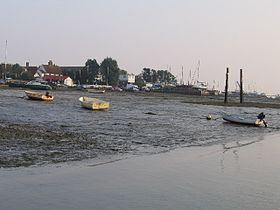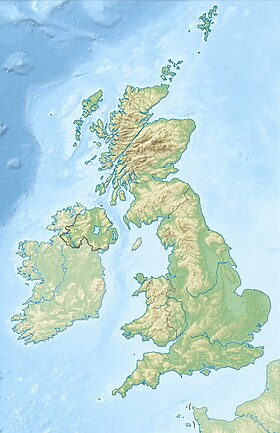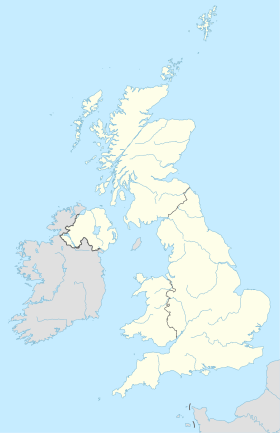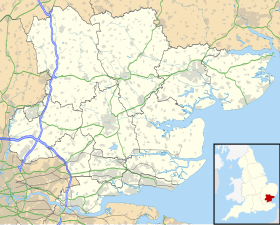Utilisateur:APictche/Brouillon/West Mersea
| West Mersea | |||||
 Bord de mer à West Mersea. | |||||
| Administration | |||||
|---|---|---|---|---|---|
| Pays | |||||
| Nation | |||||
| Région | Angleterre de l'Est | ||||
| Comté | Essex | ||||
| District | Colchester | ||||
| Démographie | |||||
| Population | 7 183 hab. (2011[1]) | ||||
| Géographie | |||||
| Coordonnées | 51° 46′ 42″ nord, 0° 55′ 00″ est | ||||
| Localisation | |||||
| Géolocalisation sur la carte : Royaume-Uni
Géolocalisation sur la carte : Royaume-Uni
Géolocalisation sur la carte : Essex
Géolocalisation sur la carte : Angleterre
| |||||
| modifier |
|||||
West Mersea est une petite ville et une circonscription électorale en Angleterre. Avec East Mersea, c'est l'une des deux agglomérations de Mersea Island, au sud de Colchester.
Hébergeant le West Mersea Yacht Club et une station de sauvetage en mer RNLI, la ville organise une régate annuelle, habituellement en août, appelée Mersea Week.
Histoire
modifierLes édifices romains et les mosaïques romaines près du quai attestent de l'existence d'une petite colonie et d'un port sur la place de la ville moderne, avec une voie romaine la reliant à la ville voisine de Camulodunum (actuelle Colchester)[2]. Le tumulus tout proche, au nord de la ville est également romain[3].
Édouard le Confesseur accorde l'île à l'abbaye Saint-Ouen de Rouen en 1046. Le prieuré de West Mersea est alors établi.
En 1963, la station de sauvetage a été créée à côté du West Mersea Yacht Club, l’une des dix premières stations de sauvetage côtières des Îles britanniques[4].
Le canot de sauvetage de classe D a été remplacé par un canot de sauvetage de classe B, l'Atlantic 21, en 1972. En 1992, un nouveau hangar à bateaux et une cale de halage ont été ouverts par le duc de Kent. En 2001, une embarcation de sauvetage de classe B Atlantic 75 est stationnée à West Mersea. En 2015, elle est remplacée par l'actuel navire de classe B Atlantic 85, baptisé Just George , financé par 210 000 £ de dons de la communauté[5]
Roman buildings and tessalated pavements close to the quayside have led to suggestions that a small Roman settlement and port existed on the site of the modern town, with a road linking it to the nearby town of Camulodunum (modern Colchester).[6] The nearby burial mound to the north of the town is also Roman.[7]
Edward the Confessor granted the island to the abbey of St. Ouen in Rouen, France, in 1046, and the Priory of West Mersea was established.
In 1963, the lifeboat station was established next to the West Mersea Yacht Club, one of the first ten inshore lifeboat stations in the British Isles.[8].
Originally served by a D class lifeboat, this was replaced by a B class, Atlantic 21, lifeboat in 1972. In 1992, a new boathouse and slipway were opened by the Duke of Kent. In 2001, a B class Atlantic 75 lifeboat was stationed at West Mersea, and then in 2015 this was replaced with the current B class Atlantic 85 named Just George, funded by £210,000 of community donations.
West Mersea today
modifierThe town is served by a community centre, various shops, restaurants, small hotels, public houses, a petrol station, bank, library, and several churches, including the Norman St Peter and St Paul (Church of England), Roman Catholic, Methodist, and West Mersea Free Church, affiliated to the Baptist Union.
West Mersea has a high proportion of elderly people, so many of the town's amenities cater for them.
The island has a substantial number of caravan parks, and along with other areas of the Essex coast, the island attracts many visitors from London and the Home Counties in summer.
A publication, the Mersea Courier, lists local activities. These include Pond Watch, The Night Sky, Christian Viewpoint and Speed Learn.
The Island is famous for its oysters, taken from oyster beds dating back to the Roman era.
References
modifier- « Town/Ward population 2011 » (consulté le )
- Crummy, Philip, City of Victory; the story of Colchester - Britain's first Roman town, Colchester Archaeological Trust, (ISBN 1 897719 04 3).
- J.M.C. Toynbee, Death and Burial in the Roman World. Published by Thames and Hudson, Thames and Hudson, (ISBN 0-8018-5507-1).
- (en) « 1963: Inflatable lifeboats », sur rnli.org (consulté le )
- Godfrey Thomas, « West Mersea Lifeboats: May 2015 Report », sur West Mersea Lifeboats, (consulté le )
- Crummy, Philip (1997) . Published by Colchester Archaeological Trust ( (ISBN 1 897719 04 3))
- Toynbee, J.M.C. (1996) Death and Burial in the Roman World. Published by Thames and Hudson. ( (ISBN 0-8018-5507-1))
- (en) « 1963: Inflatable lifeboats », sur rnli.org (consulté le )



